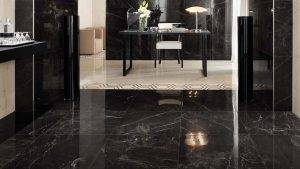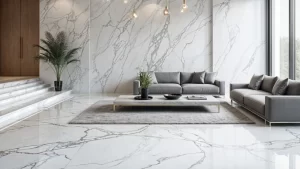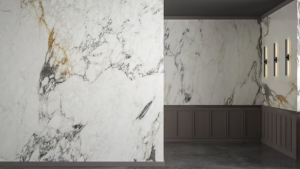Marble is one of the most elegant and luxurious materials used in home decor. Its timeless beauty and natural veining make it a favourite for flooring, countertops, and walls. However, it requires proper care and maintenance to keep marble looking its best. Unlike other stones, marble is porous and can be sensitive to stains, scratches, and acidic substances. Without the right maintenance, it can lose its shine and develop dull spots over time.
Many homeowners struggle with maintaining marble surfaces, especially when it comes to cleaning unsealed marble, removing stains from countertops, and keeping marble floors looking polished. The key to preserving marble’s beauty is understanding how to clean and protect it properly. Whether you have marble countertops in your kitchen or a marble floor in your living room, taking the right steps can keep it looking brand new for years.
This guide will provide essential tips for daily cleaning, stain removal, sealing, and preventing damage. You will also learn about choosing the right cleaning products, the importance of sealing, and the best ways to prevent etching and scratches. By following these simple care techniques, you can enjoy the beauty of your marble surfaces for a long time.
Understanding Marble Surfaces
- Marble is a type of natural stone that forms when limestone is exposed to high heat and pressure.
- It is available in different colours and patterns, with unique veining that adds character.
- Being porous, marble absorbs liquids quickly, making it prone to stains.
- It is softer than granite, which means it can scratch and chip more easily.
Types of Marble and Their Maintenance Needs
| Type of Marble | Features | Maintenance Tips |
| Carrara Marble | White with grey veins | Needs regular sealing to prevent stains |
| Statuario Marble | Bright white with bold veins | Requires delicate handling and periodic polishing |
| Mugla White Marble | Soft white with light patterns | Avoid harsh chemicals and clean with mild soap |
| Vietnam White Marble | Pure white and smooth texture | Needs gentle cleaning and immediate stain removal |
Daily Maintenance Tips for Marble Surfaces
- Wipe surfaces daily with a soft, damp cloth to remove dust and dirt.
- Use a gentle, pH-balanced cleaner to protect the stone.
- Avoid using acidic cleaners like vinegar and lemon juice.
- Immediately clean up spills to prevent stains.
- Place mats and coasters under glasses and dishes to prevent rings and marks.
How to Clean Unsealed Marble
Unsealed marble is more vulnerable to stains and scratches. Follow these steps to clean it safely:
- Dust and Wipe: Use a microfiber cloth to remove dust and debris.
- Mild Soap Solution: Mix a few drops of mild dish soap with warm water and use a soft cloth to clean the surface.
- Rinse Well: Wipe with a clean damp cloth to remove soap residue.
- Dry Immediately: Use a dry towel to prevent water spots.
Tip: Always test a small area before using any new cleaner on unsealed marble.
How to Clean Marble Countertop Stains
| Stain Type | Cleaning Solution |
| Oil Stains | Apply a mixture of baking soda and water, let sit for 24 hours, then wipe off. |
| Wine & Coffee Stains | Use a mixture of hydrogen peroxide and water, and blot gently with a soft cloth. |
| Water Rings | Buff with a dry cloth and a few drops of marble polish. |
How to Care for Marble Countertops
- Use cutting boards: Never cut directly on marble surfaces to prevent scratches and damage.
- Seal regularly: Apply a marble sealer every 6-12 months to protect against stains and moisture absorption.
- Avoid placing hot pots: Always use stand or heat-resistant pads to prevent thermal shock and discolouration.
- Dust frequently: Prevent dirt buildup with routine wiping using a soft, dry cloth.
- Use pH-neutral cleaners: Harsh chemicals can dull the surface—opt for mild, marble-safe cleaners.
- Wipe spills immediately: Marble is porous, so clean up liquids like wine, coffee, or oil quickly to avoid stains.
- Avoid abrasive scrubbers: Use a microfiber cloth or sponge instead of steel wool or rough pads to maintain the smooth finish of marble stone surfaces.
The Importance of Sealing Your Marble
Sealing helps prevent stains and damage, extending the life of your marble surfaces. Here’s how to do it:
- Clean the marble surface thoroughly with a damp cloth and a marble-safe cleaner.
- Apply a high-quality marble sealer using a soft cloth or sponge in even strokes.
- Let it sit for 15-30 minutes to allow the sealant to penetrate the stone.
- Wipe away the extra sealer with a dry, clean cloth.
- Allow the marble to cure for at least 24 hours before regular use.
- Repeat the process every 6-12 months for the best protection, especially in high-use areas like kitchens and bathrooms.
Preventing Damage and Etching
Marble is prone to etching and damage, but with proper care, you can maintain its beauty:
- Use rugs and mats in high-traffic areas to reduce wear and tear on marble flooring.
- Avoid dragging heavy furniture over marble floors to prevent scratches—use felt pads instead.
- Clean up acidic spills immediately: Lemon juice, vinegar, and soda can cause etching, so wipe them away promptly.
- Use coasters under glasses and cups to prevent water rings and stains on marble countertops.
- Avoid using bleach and ammonia-based cleaners, as they can degrade the stone’s finish over time.
Choosing the Right Marble for Your Space
Selecting the perfect marble depends on the intended use and aesthetic preference:
- Marble tiles are ideal for bathroom and kitchen walls, adding elegance and sophistication.
- Dark marble varieties, such as black or brown, offer a dramatic, bold appearance and hide stains better.
- White marble tiles create a bright and modern look, making spaces feel open and airy.
- Marble stone countertops and walls elevate interiors with a timeless and natural appeal.
- Polished marble adds a glossy, refined look, while honed marble provides a softer, matte finish that resists scratches.
- A white marble floor enhances luxury and gives an illusion of spaciousness in homes and commercial spaces.
Finding a Reliable Marble Supplier
Choosing a trustworthy supplier ensures you receive quality marble that suits your needs:
- A reliable marble supplier should provide a wide variety of options, from slabs to tiles, in different colours and finishes.
- Marble suppliers in the UAE offer premium stones with professional installation services, ensuring durability and elegance.
- If you’re looking for the best deals, check with marble suppliers in Dubai for competitive pricing and bulk purchase discounts.
- Marble suppliers in Sharjah ensure authenticity and quality, offering locally sourced and imported options.
- Consider suppliers who offer after-sales services, such as sealing and maintenance guidance, to prolong the life of your marble.
Conclusion
Proper care and maintenance of marble surfaces ensure their beauty and durability for years to come. Regular cleaning, sealing, and protecting against stains and scratches can keep your marble in stainless condition. Whether you have countertops, flooring, or wall cladding, following the right care techniques will preserve the luxurious appeal of marble. By choosing a trusted supplier, such as marble suppliers in UAE, and using high-quality materials, you can enjoy stunning marble surfaces that elevate your home’s aesthetics. Investing time in maintenance today will help your marble retain its elegance and charm for generations.
Frequently Asked Questions
What is the best way to clean marble surfaces daily?
Use a soft cloth or microfiber towel with a pH-neutral cleaner to gently wipe the surface. Don’t use acidic cleaners like vinegar or lemon juice because they can damage the surface. For routine cleaning, warm water and mild dish soap work well.
How often should I seal my marble countertops?
Sealing should be done every 6-12 months, depending on the level of usage and exposure to spills. High-traffic areas like kitchen countertops may need sealing more frequently, while bathroom surfaces may require it less often.
Can I use baking soda to clean marble?
Yes, but use it sparingly. Baking soda is mildly abrasive and can damage the marble’s finish if left on too long. If used, mix it with water to form a paste, apply gently, and rinse off immediately with clean water.
How do I remove water stains from marble?
Buff the affected area with a dry cloth and a few drops of marble polish. If the stain persists, make a paste with baking soda and water, apply it to the stain, let it sit for a few hours, and then wipe it off with a damp cloth.
Why does my marble surface look dull?
Dullness is often caused by etching from acidic substances like citrus, wine, or vinegar. To restore the shine, use a marble polishing powder or a professional-grade marble polish. Regular sealing and proper maintenance help prevent further dulling.






